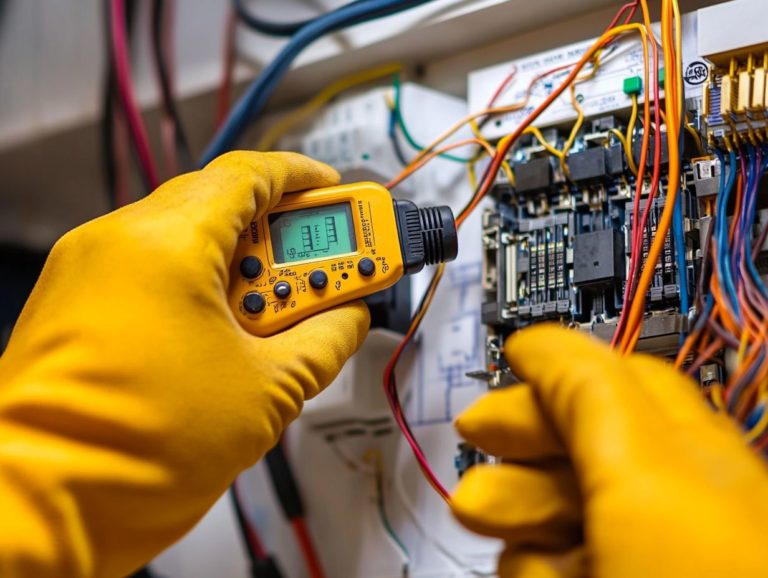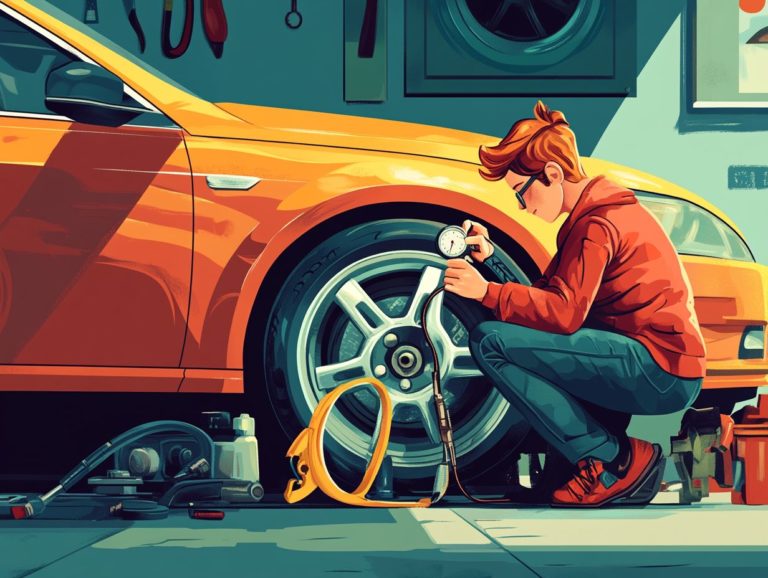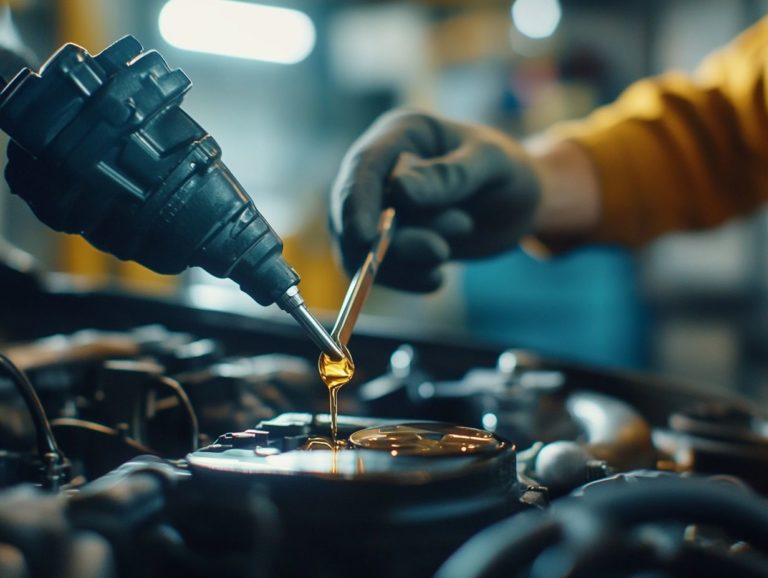What to Do When Your Check Engine Light Comes On?
The check engine light can stir up quite a bit of anxiety for many drivers. It often indicates a variety of potential issues lurking under the hood. Understanding what this warning signifies and how it operates is essential for maintaining your vehicle’s overall health.
This article delves into common triggers for the light, guiding you through the vital steps to take when it illuminates. You will also learn how to prevent future warnings with effective maintenance practices.
Staying informed empowers you to keep your ride running smoothly!
Contents
- Key Takeaways:
- Understanding the Check Engine Light
- Common Causes of a Check Engine Light
- What to Do When the Light Comes On
- Diagnosing the Problem
- Addressing the Issue
- Preventing Future Check Engine Light Warnings
- Frequently Asked Questions
- What does it mean when my check engine light comes on?
- What should I do when my check engine light comes on?
- Can I still drive my car when the check engine light is on?
- What are common causes of the check engine light coming on?
- Will the check engine light turn off on its own?
- Can I use a code reader to diagnose the check engine light?
Key Takeaways:

- Don’t panic when your check engine light comes on. Understand what it means and how it works before taking any action.
- When the light comes on, follow the steps to take and precautions to ensure your safety and prevent further damage to your vehicle.
- Use diagnostic tools and resources to accurately diagnose the problem and address it promptly to prevent costly repairs in the future.
Understanding the Check Engine Light
The check engine light is a vital signal on your dashboard. It alerts you to potential issues that could affect your vehicle’s performance.
When it lights up, it means the internal computer has identified one or more diagnostic trouble codes related to the engine or emissions system.
Grasping the significance of this warning is vital for preserving your vehicle’s health and ensuring your safety on the road. This is especially true if you own a Toyota model from Roseville Toyota in California. Their expert automotive technicians are ready to provide a comprehensive vehicle inspection and the necessary service to keep your ride in optimal condition.
What it Means and How it Works
The check engine light is your vehicle s way of giving you a heads-up. It s a signal from the electronic control module (the brain of your car’s engine) that something’s amiss in the engine or emissions system.
This crucial function depends on a sophisticated network of sensors and actuators scattered throughout your vehicle. These components constantly monitor key parameters such as temperature, pressure, and airflow.
When the electronic control module detects a malfunction, it lights up that warning signal and logs a diagnostic trouble code (DTC) simultaneously. You can retrieve this information using an onboard diagnostic scanner (a tool that connects to your vehicle to read error codes).
This communication system allows mechanics to swiftly identify issues impacting your vehicle s performance. It also offers insights into important aspects like fuel efficiency, ignition timing, and exhaust emissions. Understanding these codes can be immensely beneficial for maintaining your engine’s health and ensuring compliance with environmental regulations.
Common Causes of a Check Engine Light
A variety of common issues can prompt your vehicle’s check engine light to illuminate. These can range from a simple loose gas cap to more serious concerns like a malfunctioning oxygen sensor or catalytic converter failure.
Identifying Possible Issues
Identifying potential issues that trigger the check engine light can save you from serious vehicle troubles and hefty repair bills.
By using an OBD-II scanner, you can effortlessly retrieve diagnostic trouble codes (DTCs) that shed light on the underlying causes of those warnings. This handy tool enables you to quickly interpret the codes, which might indicate common problems like engine misfires, malfunctioning oxygen sensors, or even trouble with the catalytic converter.
Tackling these issues early on is essential; ignoring them could lead to more significant damage and costlier repairs in the future. Understanding these codes gives you the power to make informed decisions about necessary maintenance or repairs, ensuring your vehicle remains in top shape.
What to Do When the Light Comes On
When the check engine light illuminates, it is essential to act promptly to diagnose the issue and ensure your driving safety. Begin by scheduling a service appointment at a trustworthy service center.
Act now to tackle any potential problems before they escalate, keeping your vehicle in optimal condition.
Steps to Take and Precautions

Taking the right steps when that check engine light illuminates can significantly impact how effectively you address potential vehicle issues.
When this warning graces your dashboard, the first thing you should do is perform a visual inspection under the hood and around your vehicle for any obvious signs of trouble think loose hoses or leaking fluids. It s also important to reflect on your recent driving habits. Notice any rough idling or changes in fuel efficiency, as these details can offer vital context for the situation.
If everything looks fine on the surface, it s prudent to consult with a qualified Toyota dealer or service center.
Their expertise, coupled with specialized diagnostic tools, can swiftly pinpoint the root cause of the problem, ensuring that any underlying issues are addressed before they escalate into more significant concerns.
Diagnosing the Problem
To diagnose the issue behind that illuminated check engine light, you’ll want to use advanced diagnostic tools, like an OBD-II scanner, which is a tool that reads vehicle error codes. This device will read the fault codes from your vehicle’s internal computer, providing you with the insights needed to pinpoint the problem accurately.
Using Diagnostic Tools and Resources
Using the right diagnostic tools is crucial for accurately assessing your vehicle’s condition and truly understanding what that check engine light is trying to tell you.
Among the most sought-after tools are OBD-II scanners, which provide a valuable glimpse into your vehicle’s onboard diagnostic system. These tools can pinpoint specific trouble codes, which are messages that indicate problems within your vehicle, tied to particular issues, enabling you to troubleshoot more efficiently and effectively.
Along with OBD-II scanners, consider using other diagnostic tools like multimeters and pressure gauges to uncover any hidden problems.
By leveraging these tools, you not only identify the source of the check engine light but also gain insight into potential repair costs. This gives you the power to make informed decisions about the necessary maintenance and repairs your vehicle may require.
Addressing the Issue
Once you ve diagnosed the underlying issue triggering the check engine light, addressing it quickly helps you avoid higher repair costs and ensures your vehicle maintains optimal performance.
Repair Options and Costs
Repair options for the issues flagged by the check engine light can vary significantly in both complexity and cost, depending on the specific diagnosis.
You ll often find mechanics starting with a diagnostic scan to identify the root cause, which could be anything from a simple loose gas cap to more complicated problems like a faulty oxygen sensor or transmission issues.
The costs associated with these repairs can shift dramatically based on your vehicle s make and model, local labor rates, and the price of any necessary parts.
For instance, minor fixes might only set you back $50 to $150, while more intricate repairs could easily escalate into the hundreds or even thousands, particularly if specialized equipment is required. Don t forget, factors like vehicle age, mileage, and previous maintenance history also play a vital role in influencing these repair decisions.
Preventing Future Check Engine Light Warnings
To prevent future check engine light warnings, you should engage in proactive vehicle maintenance and adopt best practices that enhance fuel efficiency and overall performance.
This approach not only safeguards your vehicle but also ensures a smoother, more reliable driving experience.
Don’t wait! Address that check engine light now to keep your vehicle running smoothly! Invest in your vehicle’s health today for a safer ride tomorrow!
Maintenance Tips and Best Practices

Implementing consistent vehicle maintenance practices is essential for enhancing fuel efficiency and minimizing the chances of the check engine light turning on.
Regular checks of key components like oil, brakes, and tires not only boost performance but also allow you to catch any issues before they escalate into costly repairs.
Staying informed about the latest automotive technology can transform your experience. Features such as tire pressure monitoring systems and onboard diagnostics provide real-time feedback that s invaluable.
By adhering to service protocols, including timely oil changes and filter replacements, you ensure that your engine operates at its best and stays clean.
Choosing professional services equipped with advanced tools can significantly extend your vehicle’s longevity and reliability, leading to a smoother, more enjoyable driving experience.
Frequently Asked Questions
What does it mean when my check engine light comes on?
When your check engine light comes on, it indicates an issue with one of your vehicle’s systems. This could be anything from a loose gas cap to a more serious engine problem.
What should I do when my check engine light comes on?
The first thing to do is check your vehicle’s dashboard for any other warning lights. If there are none, you can typically continue driving but should have your vehicle checked as soon as possible.
Can I still drive my car when the check engine light is on?
In most cases, you can still drive your car when the check engine light is on. However, if the light is flashing, pull over immediately and get help!
What are common causes of the check engine light coming on?
There are many potential causes for the check engine light to illuminate, including a malfunctioning oxygen sensor, a loose gas cap, or a faulty catalytic converter. A mechanic can quickly identify the problem and save you from future headaches!
Will the check engine light turn off on its own?
Sometimes, the check engine light may turn off on its own after a few driving cycles if the issue has been resolved. However, it s important to have your vehicle checked by a mechanic to ensure there are no underlying issues.
Can I use a code reader to diagnose the check engine light?
Yes, you can use a code reader to retrieve the error codes associated with your check engine light. These codes can give you an idea of what is causing the light to turn on, but it s still best to have a mechanic diagnose and address the issue.






